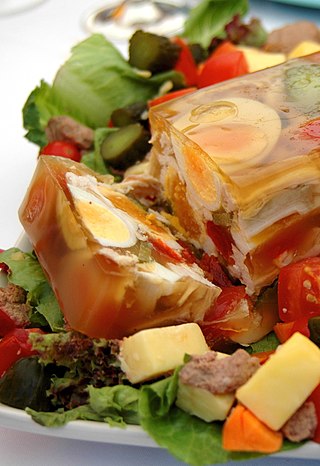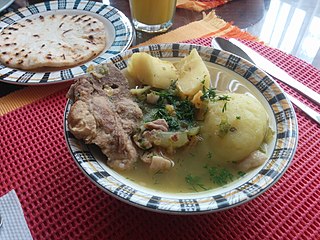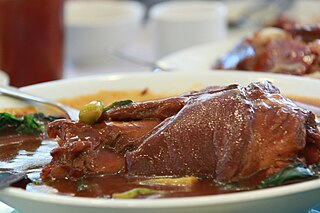
A pig's trotter, also known as a pettitoe, [1] is the culinary term for a pig's foot. It is used as a cut of pork in various dishes around the world, and experienced a resurgence in the late 2000s. [2]

A pig's trotter, also known as a pettitoe, [1] is the culinary term for a pig's foot. It is used as a cut of pork in various dishes around the world, and experienced a resurgence in the late 2000s. [2]


Before sale, the trotters are cleaned and typically have the hairs pulled with a hot tank and beaters. [3] They are often used in cooking to make stocks, as they add thickness to gravy, although they are also served as a normal cut of meat. [3] In Puerto Rico, a tomato-based stew of pigs' trotters with chickpeas is called patitas de cerdo. Sometimes potatoes or butternut are added. Chef Marco Pierre White has long served trotters at his restaurants, [4] based on the original recipe of mentor Pierre Koffmann. [5] In the New York City restaurant Hakata Tonton, 33 of the 39 dishes served contain pigs' trotters. [6]
Following the late-2000s financial crisis, there has been a boom in popularity of pigs' trotters in the United Kingdom as a revival in cheap meat recipes occurred. [2] In 2008, British supermarket Waitrose reintroduced trotters to its stores, [4] and found that they quickly became popular. [2] In 2009, Pierre Koffmann set up a pop-up restaurant, and found that diners ate an entire month's stock of 500 pigs' trotters in less than a week. [2]
In Norwegian tradition, pigs' feet are salted and boiled and served as syltelabb . This is a pre-Christmas dish because the pig was slaughtered before Christmas, and everything was used. Today syltelabb is for enthusiasts. [7]


Head cheese or brawn is a cold cut terrine or meat jelly that originated in Europe. It is made with flesh from the head of a calf or pig, typically set in aspic, and usually eaten cold, at room temperature, or in a sandwich. Despite its name the dish is not a cheese and contains no dairy products. The parts of the head used vary, and may include the tongue but do not commonly include the brain, eyes or ears. Trimmings from more commonly eaten cuts of pork and veal are often used, and sometimes the feet and heart, with gelatin added as a binder.

Tripe is a type of edible lining from the stomachs of various farm animals. Most tripe is from cattle, pigs and sheep.

Offal, also called variety meats, pluck or organ meats, is the internal organs of a butchered animal. The word does not refer to a particular list of edible organs, and these lists of organs vary with culture and region, but usually exclude skeletal muscle. Offal may also refer to the by-products of milled grains, such as corn or wheat.

Aspic or meat jelly is a savory gelatin made with a meat stock or broth, set in a mold to encase other ingredients. These often include pieces of meat, seafood, vegetable, or eggs. Aspic is also sometimes referred to as aspic gelée or aspic jelly. In its simplest form, aspic is essentially a gelatinous version of conventional soup.

Chicharrón is a dish generally consisting of fried pork belly or fried pork rinds. Chicharrón may also be made from chicken, mutton, or beef.

Sancocho is a traditional stew in Canarian cuisine and several Latin American cuisines. Latin variations represent popular national dishes in Dominican Republic, Colombia, Cuba, Honduras, Mexico, Ecuador, Panama, Puerto Rico, Trinidad and Tobago, and Venezuela. It usually consists of large pieces of meat, tubers and vegetables served in a broth.

Kare-kare is a Philippine stew that features a thick savory peanut sauce. It is generally made from a base of stewed oxtail, beef tripe, pork hocks, calves' feet, pig's feet or trotters, various cuts of pork, beef stew meat, and occasionally offal. Vegetables, such as eggplant, Chinese cabbage, or other greens, daikon, green beans, okra, and asparagus beans, are added. The stew is flavored with ground roasted peanuts or peanut butter, onions, and garlic. It is colored with annatto and can be thickened with toasted or plain ground rice. Variations of kare-kare can be made with seafood, such as prawns, squid, and mussels, or exclusively from vegetables.

Sopa de mondongo is a soup made from diced tripe slow-cooked with vegetables such as bell peppers, onions, carrots, cabbage, celery, tomatoes, cilantro, garlic or root vegetables. The dish is generally prepared in former Spanish colonies in Latin America, Caribbean, and in the Philippines.

Honduran cuisine is a fusion of Mesoamerican, Spanish, Caribbean and African cuisines. There are also dishes from the Garifuna people. Coconut and coconut milk are featured in both sweet and savory dishes. Regional specialties include sopa de caracol, fried fish, tamales, carne asada and baleadas. Other popular dishes include meat roasted with chismol and carne asada, chicken with rice and corn, and fried fish with pickled onions and jalapeños. In the coastal areas and the Bay Islands, seafood and some meats are prepared in many ways, including with coconut milk. Among the soups the Hondurans enjoy are bean soup, mondongo soup, seafood soups and beef soups. Generally all of these soups are mixed with plantains, yuca, and cabbage, and served with corn tortillas.

The cuts of pork are the different parts of the pig which are consumed as food by humans. The terminology and extent of each cut varies from country to country. There are between four and six primal cuts, which are the large parts in which the pig is first cut: the shoulder, loin, belly and leg. These are often sold wholesale, as are other parts of the pig with less meat, such as the head, feet and tail. Retail cuts are the specific cuts which are used to obtain different kinds of meat, such as tenderloin and ham. There are at least 25 Iberian pork cuts, including jamón.

Crispy pata is a Filipino dish consisting of deep fried pig trotters or knuckles served with a soy-vinegar dip. It can be served as party fare or an everyday dish. Many restaurants serve boneless pata as a specialty. The dish is quite similar to the German Schweinshaxe.

Breaded cutlet or braised cutlet is a dish made from coating a cutlet of meat with breading or batter and either frying or baking it.

Paksiw is a Filipino style of cooking, whose name means "to cook and simmer in vinegar". Common dishes bearing the term, however, can vary substantially depending on what is being cooked.

Pork rind is the culinary term for the skin of a pig. It can be used in many different ways.

Babi kecap is an Indonesian braised pork with sweet soy sauce. It is a Chinese Indonesian classic, due to its simplicity and popularity among Chinese Indonesian households. It is also popular among non-Muslim Indonesians, such as the Balinese, Ambonese, Bataks, Minahasans, and Dayaks, and in the Netherlands among the Indo-Dutch, where it is known as babi ketjap, owing to colonial ties with Indonesia. In the Netherlands, the dish might also be served within an opulent rijsttafel banquet.

Pata tim, also spelled patatim, is a Filipino braised pork hock dish slow-cooked until very tender in soy sauce, black peppercorns, garlic, bay leaves, and star anise sweetened with muscovado sugar. It also commonly includes péchay and mushrooms. The dish is commonly served in regions in the Philippines with large Chinese Filipino populations, especially in the Binondo district of Manila.

Indo cuisine is a fusion cooking and cuisine tradition, mainly existing in Indonesia and the Netherlands, as well as Belgium, South Africa and Suriname. This cuisine characterized of fusion cuisine that consists of original Indonesian cuisine with Eurasian-influences—mainly Dutch, also Portuguese, Spanish, French and British—and vice versa. Nowaday, not only Indo people consume Indo cuisine, but also Indonesians and Dutch people.